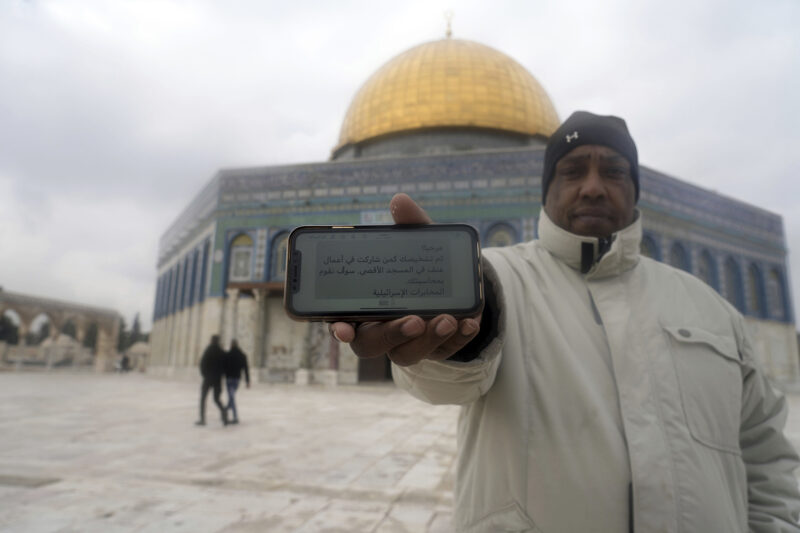Fresh off a fellowship studying artificial intelligence at Stanford University, reporter Garance Burke returned to AP’s investigative team with an idea for a gripping global project: Could AP staff track how policing worldwide had changed since the pandemic began?
More than a year later, Burke and the cross-format, cross-border team she led produced a sweeping investigation revealing how law enforcement across the globe mobilized new mass surveillance tools during the pandemic for purposes entirely unrelated to COVID-19. With bylines from Burke in San Francisco, California, Josef Federman in Israel, Huizhong Wu in Taiwan, Krutika Pathi and Rishabh Jain in India and Rod McGuirk in Australia, the team delivered four powerful government accountability stories that showcased the power of AP’s global reach.
The stories, video, graphics and photographs centered the voices of people who were directly impacted, showing how diverse pandemic tools were instead used to halt activists’ travel, amass private data and investigate crimes. The massive, global effort drew from the talents of more than 35 AP staffers across regions and departments, and received support from the Pulitzer Center on Crisis Reporting, the Starling Lab for Digital Integrity, and partners University of California Berkeley’s Human Rights Center Investigations Lab.
Burke and project manager Sharon Lynch worked with the team for more than a year to file FOIA requests, gather exclusive documents and seek out sources who were following how COVID-19 gave police officials justification to embed long-lasting tracking tools in society.
The documents helped explain how the technologies worked, but it took months of sourcing to find people who were directly impacted and to trace how the balance between privacy and national security had shifted, as had occurred after the Sept. 11 terrorist attacks. Federman traveled to Jerusalem and Pathi went to Hyderabad to interview people at the heart of the story, while Wu pored over Chinese government contracts and McGuirk chased down a case that exemplified police overreach.
The biggest challenge in Israel was finding someone who received the threatening text message and would be willing to speak about it on the record. Two Palestinian colleagues scoured Arabic social media and did word-of-mouth networking that eventually led us to Majd Ramlawi, a 19-year-old man who works in a coffee shop in Jerusalem’s Old City.
Ramlawi initially was hesitant to talk because he did not want trouble with the authorities. He eventually agreed to show Federman the message he received on his phone. Then, Federman was able to persuade him to speak on the record. Only when Federman returned to him for a second conversation, nearly a year after our first interview, did he agree to be photographed. In the end, he gave material that ended up becoming the lead of the story.

Jain spent weeks negotiating with the Hyderabad police, eventually scoring an exclusive on-camera interview with the police commissioner and access to the department’s gleaming new tech hub. Sam McNeil, Serginho Roosblad and Jeannie Ohm worked long hours to find creative ways to tell the video story, centered on people’s individual stories. Meanwhile, Burke gleaned FOIA material to quantify the U.S. agencies’ secrecy and pandemic overreach, while Maye-E Wong, Dario Lopez, Justin Myers, Peter Hamlin and Francois Duckett built a stunning digital presentation that included dispatches from nine other countries and an embedded tweet harnessing new open-source authentication technology piloted by the Starling Lab.
The result was impressive play for both the video and print story, which garnered more than 117,000 pageviews on AP website by Dec. 25. Outlets as diverse as The Washington Post, Stars and Stripes and the PBS Newshour ran the piece, while The Hill’s TV show “Rising” devoted a segment to the story, which was also featured on the Tech Policy Press podcast. In the days that followed, the story was read around the world after being translated into Spanish and Arabic. “Must read” a MacArthur genius who specializes in algorithmic accountability tweeted about AP’s story. An author of the Biden administration’s AI Bill of Rights posted: “This is an important article. Because it… keeps… happening. This is yet another reason safeguards on public-facing tech deployment are necessary.”
For using Burke’s expertise and keen interest in AI to bring forth a disturbing story on surveillance and policing with global ramifications, the team of Burke, Federman, Jain, Wu and McGuirk, supported by numerous other colleagues across the AP, share Best of the Week – First Winner.
Visit AP.org to request a trial subscription to AP’s video, photo and text services.
For breaking news, visit apnews.com.




